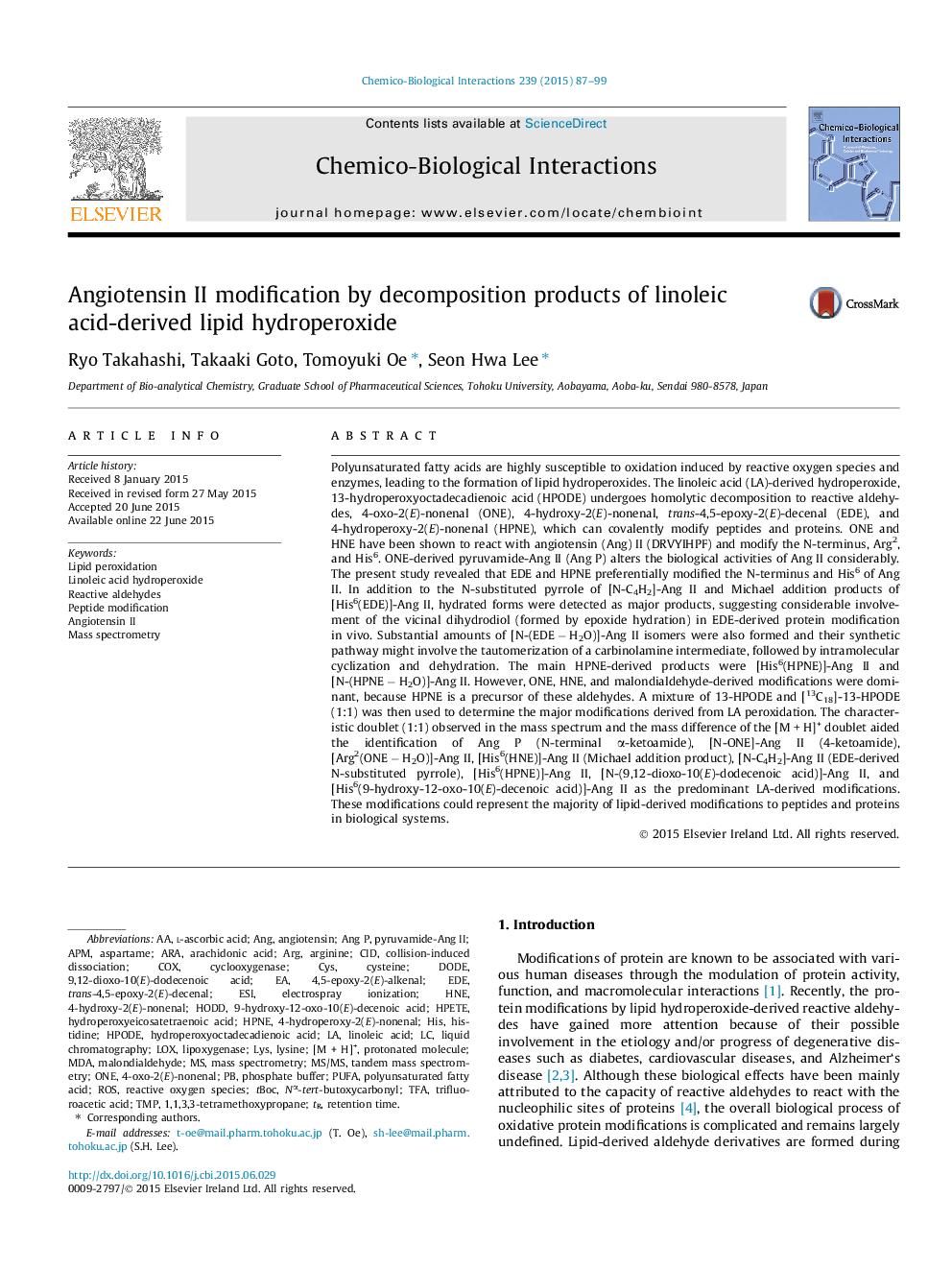| کد مقاله | کد نشریه | سال انتشار | مقاله انگلیسی | نسخه تمام متن |
|---|---|---|---|---|
| 5847845 | 1561602 | 2015 | 13 صفحه PDF | دانلود رایگان |

- EDE and HPNE preferentially modified the N-terminus and His6 of angiotensin (Ang) II.
- Mixture of [12C18]- and [13C18]-13-HPODE was incubated with Ang II and ascorbic acid.
- Doublet MS peak and mass difference aided the identification of modified Ang II.
- Major modifications derived from linoleic acid peroxidation were determined.
- Identified modifications as potential biomarkers of lipid-mediated oxidative damage.
Polyunsaturated fatty acids are highly susceptible to oxidation induced by reactive oxygen species and enzymes, leading to the formation of lipid hydroperoxides. The linoleic acid (LA)-derived hydroperoxide, 13-hydroperoxyoctadecadienoic acid (HPODE) undergoes homolytic decomposition to reactive aldehydes, 4-oxo-2(E)-nonenal (ONE), 4-hydroxy-2(E)-nonenal, trans-4,5-epoxy-2(E)-decenal (EDE), and 4-hydroperoxy-2(E)-nonenal (HPNE), which can covalently modify peptides and proteins. ONE and HNE have been shown to react with angiotensin (Ang) II (DRVYIHPF) and modify the N-terminus, Arg2, and His6. ONE-derived pyruvamide-Ang II (Ang P) alters the biological activities of Ang II considerably. The present study revealed that EDE and HPNE preferentially modified the N-terminus and His6 of Ang II. In addition to the N-substituted pyrrole of [N-C4H2]-Ang II and Michael addition products of [His6(EDE)]-Ang II, hydrated forms were detected as major products, suggesting considerable involvement of the vicinal dihydrodiol (formed by epoxide hydration) in EDE-derived protein modification in vivo. Substantial amounts of [N-(EDE â H2O)]-Ang II isomers were also formed and their synthetic pathway might involve the tautomerization of a carbinolamine intermediate, followed by intramolecular cyclization and dehydration. The main HPNE-derived products were [His6(HPNE)]-Ang II and [N-(HPNE â H2O)]-Ang II. However, ONE, HNE, and malondialdehyde-derived modifications were dominant, because HPNE is a precursor of these aldehydes. A mixture of 13-HPODE and [13C18]-13-HPODE (1:1) was then used to determine the major modifications derived from LA peroxidation. The characteristic doublet (1:1) observed in the mass spectrum and the mass difference of the [M + H]+ doublet aided the identification of Ang P (N-terminal α-ketoamide), [N-ONE]-Ang II (4-ketoamide), [Arg2(ONE â H2O)]-Ang II, [His6(HNE)]-Ang II (Michael addition product), [N-C4H2]-Ang II (EDE-derived N-substituted pyrrole), [His6(HPNE)]-Ang II, [N-(9,12-dioxo-10(E)-dodecenoic acid)]-Ang II, and [His6(9-hydroxy-12-oxo-10(E)-decenoic acid)]-Ang II as the predominant LA-derived modifications. These modifications could represent the majority of lipid-derived modifications to peptides and proteins in biological systems.
Journal: Chemico-Biological Interactions - Volume 239, 5 September 2015, Pages 87-99